

In the 2019 Macedonian documentary Honeyland, the main character Hatidže Muratova is one of the last wild beekeepers in Europe. Her bees live in small caves, openings in rock walls, and skeps, and she travels and climbs up rock faces to get to them.
While the story of her beekeeping experience is poignant and inspiring, most modern beekeepers would not want to tolerate the struggles that she endures to keep her bees. There are much easier and more convenient ways to practice sustainable beekeeping, and beekeeping is becoming more and more accessible for people of all abilities.
In the 2019 Macedonian documentary Honeyland, the main character Hatidže Muratova is one of the last wild beekeepers in Europe. Her bees live in small caves, openings in rock walls, and skeps, and she travels and climbs up rock faces to get to them.
While the story of her beekeeping experience is poignant and inspiring, most modern beekeepers would not want to tolerate the struggles that she endures to keep her bees. There are much easier and more convenient ways to practice sustainable beekeeping, and beekeeping is becoming more and more accessible for people of all abilities.
There are many types of bee hives, and you, the beekeeper, can choose how you want to keep your bees. There is a type of beehive for every type of beekeeper.
The basics of all bee hives are the same—they are a space for bees to build comb, raise more bees, and store food. Many hive features are interchangeable—techniques from one type of hive can be applied to others. For example, If you want the natural comb of a Kenyan top bar hive, you can put foundationless frames in your Langstroth or National hive.
Honeybees naturally like to live in hollow trees; they want a dry cavity with very little light, a space that accommodates a large population provides enough space for bees to build combs with brood, honey, and pollen, and has an opening that allows bees to enter and exit easily but is not so large that it lets predators enter easily.
There are many types of bee hives, and you, the beekeeper, can choose how you want to keep your bees. There is a type of beehive for every type of beekeeper.
The basics of all bee hives are the same—they are a space for bees to build comb, raise more bees, and store food. Many hive features are interchangeable—techniques from one type of hive can be applied to others. For example, If you want the natural comb of a Kenyan top bar hive, you can put foundationless frames in your Langstroth or National hive.
Honeybees naturally like to live in hollow trees; they want a dry cavity with very little light, a space that accommodates a large population provides enough space for bees to build combs with brood, honey, and pollen, and has an opening that allows bees to enter and exit easily but is not so large that it lets predators enter easily.
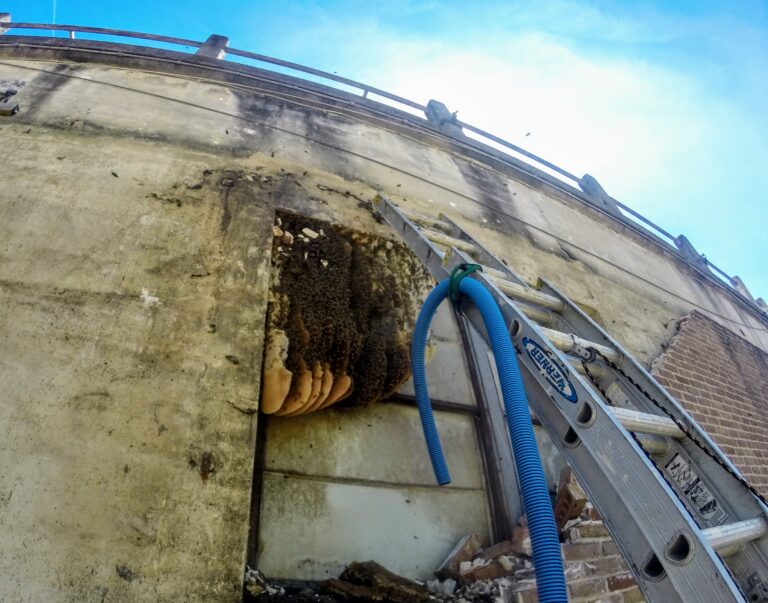
Left to their own devices, honeybees may build comb in the walls of houses, electrical boxes, small caves, and trees. Twice before I became a beekeeper, some honeybees moved into an old outhouse on our property. The outhouse toilet and the area under it seemed to provide a suitable space for what became a large colony. Our beekeeper friend came to remove them two times!
Ever since there have been beekeepers, there have been innovations and experiments in ways to keep bees. Beekeepers are always trying to invent new ways to keep bees. Some of them have worked, and others have been forgotten. (Somehow, the outhouse toilet hive never did catch on!)
Here we’ll list some that are still in use and some newer styles of hives and adaptations of older styles of hives for keeping honeybees. The beekeeping community always has a new “mouse trap” for beekeepers to use.

Left to their own devices, honeybees may build comb in the walls of houses, electrical boxes, small caves, and trees. Twice before I became a beekeeper, some honeybees moved into an old outhouse on our property. The outhouse toilet and the area under it seemed to provide a suitable space for what became a large colony. Our beekeeper friend came to remove them two times!
Ever since there have been beekeepers, there have been innovations and experiments in ways to keep bees. Beekeepers are always trying to invent new ways to keep bees. Some of them have worked, and others have been forgotten. (Somehow, the outhouse toilet hive never did catch on!)
Here we’ll list some that are still in use and some newer styles of hives and adaptations of older styles of hives for keeping honeybees. The beekeeping community always has a new “mouse trap” for beekeepers to use.
Some styles of hives are more easily adapted for beekeepers with mobility issues or disabilities than others, and location most often determines the hive style many beekeepers use. Someone in the UK may use a National hive, not because it is better, but because it is standard in their area; therefore, the equipment is readily available.
Some styles of hives are more easily adapted for beekeepers with mobility issues or disabilities than others, and location most often determines the hive style many beekeepers use. Someone in the UK may use a National hive, not because it is better, but because it is standard in their area; therefore, the equipment is readily available.
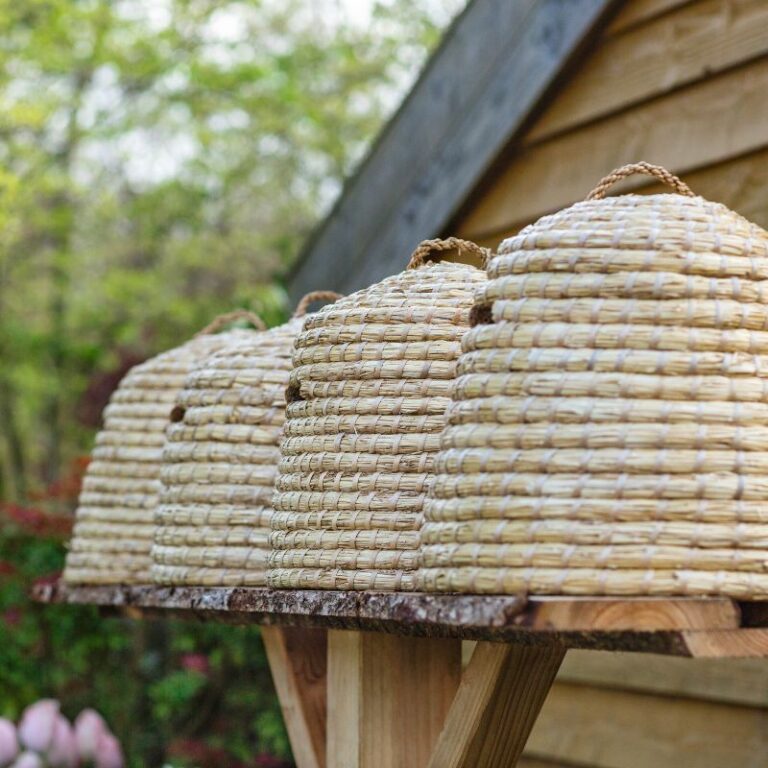
Skep
For 2000 years or more, beekeepers have used a type of hive called a skep. A skep is an upside-down basket made of straw, clay, or wicker. Honey bees build comb however they want inside the skep, and when it is time to harvest for honey, most of the hive is destroyed, and the beekeeper has to go find a new swarm with which to start over.
Originally, beekeepers’ goals weren’t for large scale honey production, so the small skep produced enough honey for their families.
While skeps or something like them have been used all over the world, most beekeepers have stopped using them because it is impossible to inspect the hive for pests or diseases, and the necessity of destroying the hive is wasteful. Because the hive area is relatively small, skep hives are more likely to swarm. In many places, it is illegal to use a skep because they can’t be inspected for diseases.

Skep
For 2000 years or more, beekeepers have used a type of hive called a skep. A skep is an upside-down basket made of straw, clay, or wicker. Honey bees build comb however they want inside the skep, and when it is time to harvest for honey, most of the hive is destroyed, and the beekeeper has to go find a new swarm with which to start over.
Originally, beekeepers’ goals weren’t for large scale honey production, so the small skep produced enough honey for their families.
While skeps or something like them have been used all over the world, most beekeepers have stopped using them because it is impossible to inspect the hive for pests or diseases, and the necessity of destroying the hive is wasteful. Because the hive area is relatively small, skep hives are more likely to swarm. In many places, it is illegal to use a skep because they can’t be inspected for diseases.
Langstroth Hives
Langstroth Hives
If anyone talks about beekeeping or beehives, most people in the United States will picture a Langstroth hive. These are the ubiquitous rectangular stacking boxes with standard-size frames that can be seen in almost any apiary in America.
Most beekeeping supply companies in the United States exclusively carry this style of hive because it is the most commonly used and most easily modified type. It is considered “standard” by most beekeepers in America.
If anyone talks about beekeeping or beehives, most people in the United States will picture a Langstroth hive. These are the ubiquitous rectangular stacking boxes with standard-size frames that can be seen in almost any apiary in America.
Most beekeeping supply companies in the United States exclusively carry this style of hive because it is the most commonly used and most easily modified type. It is considered “standard” by most beekeepers in America.
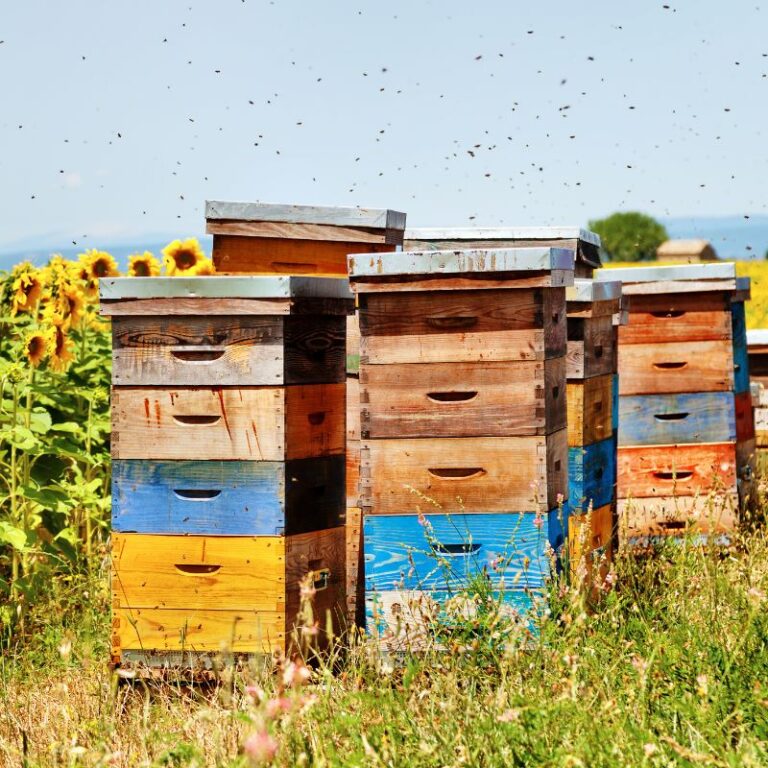
Package Bees vs Nucleus Hives: Whats the Difference?
The advantage of using standard Langstroth hive equipment, wherever you are, is that you can easily replace equipment and add equipment. Unless you are building your own equipment, it may be advantageous to use standard hives for your location. When you are considering types of beehives, this is an important factor.
If you plan to buy bees in a nuc in America and are getting started with beekeeping, it is very likely that your bees will arrive in a five-frame box on Langstroth frames. Having Langstroth Hive equipment enables you to easily install your bees.
Other hive styles will require that you buy packages of bees, which can be less than ideal.

Package Bees vs Nucleus Hives: Whats the Difference?
The advantage of using standard Langstroth hive equipment, wherever you are, is that you can easily replace equipment and add equipment. Unless you are building your own equipment, it may be advantageous to use standard hives for your location. When you are considering types of beehives, this is an important factor.
If you plan to buy bees in a nuc in America and are getting started with beekeeping, it is very likely that your bees will arrive in a five-frame box on Langstroth frames. Having Langstroth Hive equipment enables you to easily install your bees.
Other hive styles will require that you buy packages of bees, which can be less than ideal.
In 1852, L.L. Langstroth patented his hive design, which included three sizes of stackable boxes (deep, medium, and shallow) that each held 10 or 8 removable frames. 10 frames hives are the most popular size in the US, but that doesn’t mean it is the best. When we teach beekeeping classes, we always recommend getting the right size hive to fit you and your style of beekeeping.
In 1852, L.L. Langstroth patented his hive design, which included three sizes of stackable boxes (deep, medium, and shallow) that each held 10 or 8 removable frames. 10 frames hives are the most popular size in the US, but that doesn’t mean it is the best. When we teach beekeeping classes, we always recommend getting the right size hive to fit you and your style of beekeeping.
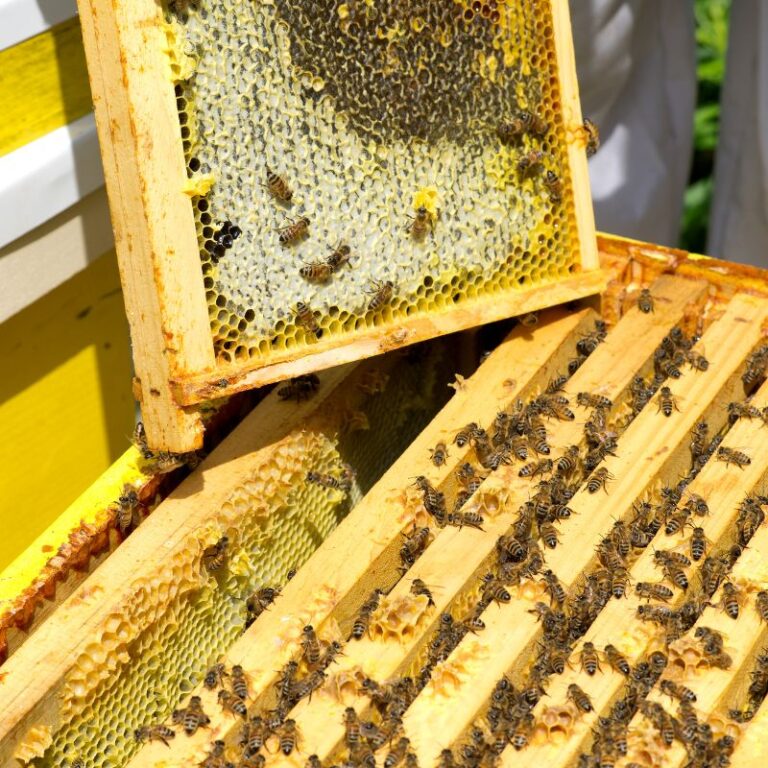
The Langstroth hive was designed with the beekeeper’s convenience in mind. Bees build comb inside frames of three different sizes: deep, medium, and shallow. Beekeepers can remove these frames during inspection to get a good look at them, and the boxes are stacked with the deep boxes at the bottom and medium/shallow boxes at the top.
While it would be difficult to lift Langstroth hive boxes from a wheelchair or with one arm, modifications have been made for Langstroth hives to make it possible for people in wheelchairs to use them.
One example is a tilting hive, made possible with a special stand and some very strong hinges. Here’s a YouTube video demonstrating a tilting modification for Langstroth hives: Easy Lift Beehive.

The Langstroth hive was designed with the beekeeper’s convenience in mind. Bees build comb inside frames of three different sizes: deep, medium, and shallow. Beekeepers can remove these frames during inspection to get a good look at them, and the boxes are stacked with the deep boxes at the bottom and medium/shallow boxes at the top.
While it would be difficult to lift Langstroth hive boxes from a wheelchair or with one arm, modifications have been made for Langstroth hives to make it possible for people in wheelchairs to use them.
One example is a tilting hive, made possible with a special stand and some very strong hinges. Here’s a YouTube video demonstrating a tilting modification for Langstroth hives: Easy Lift Beehive.
Horizontal Langstroth Hives (Also Known As Long Hives)
Horizontal Langstroth Hives (Also Known As Long Hives)
A horizontal Langstroth hive is one single long box that holds regular Langstroth frames. As the hive builds comb, a beekeeper can adjust the size by moving a “leader board” until the frames reach the other end of the box. Rather than being stacked, the frames are all on one level. When frames fill the box, it will be necessary to harvest honey or to split the hive, as there is no other way to add more space for the bees.
The horizontal Langstroth offers some helpful accommodations for many beekeepers. No heavy lifting is necessary; it can be customized for height off the ground; the beekeeper can make the hive smaller or bigger without changing boxes; and it uses regular langstroth frames, so harvesting honey is standard.
We are fans of the horizontal beehives that take Langstroth frames. The combination of the modern beehive Langstroth frames and the horizontal design makes it a great option for many beekeepers. The hard part is the horizontal hives can be tough to source, but can easily be made yourself with basic tools.
A horizontal Langstroth hive is one single long box that holds regular Langstroth frames. As the hive builds comb, a beekeeper can adjust the size by moving a “leader board” until the frames reach the other end of the box. Rather than being stacked, the frames are all on one level. When frames fill the box, it will be necessary to harvest honey or to split the hive, as there is no other way to add more space for the bees.
The horizontal Langstroth offers some helpful accommodations for many beekeepers. No heavy lifting is necessary; it can be customized for height off the ground; the beekeeper can make the hive smaller or bigger without changing boxes; and it uses regular langstroth frames, so harvesting honey is standard.
We are fans of the horizontal beehives that take Langstroth frames. The combination of the modern beehive Langstroth frames and the horizontal design makes it a great option for many beekeepers. The hard part is the horizontal hives can be tough to source, but can easily be made yourself with basic tools.
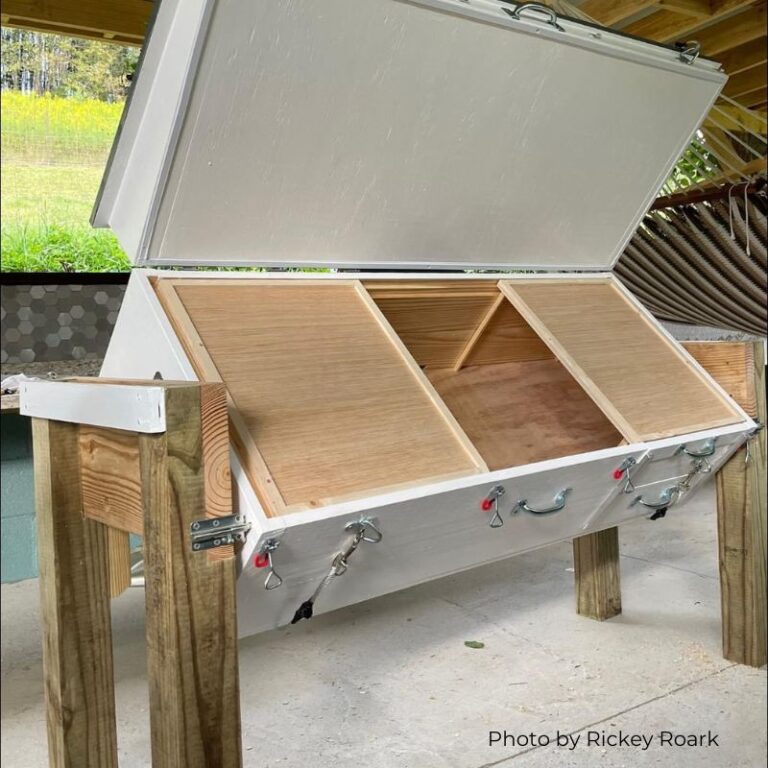
Justin Ruger, a beekeeper, interviewed in the University of Florida’s Honeybee Research and Extension Lab’s podcast “Two Bees in a Podcast,” Episode 109, has been experimenting with accessible hives like a horizontal Langstroth hive that tilts, pictured above. In the same podcast, he mentions a honey extractor that tilts made by Lyson for people in wheelchairs.
Justin Ruger has a website (AccessibleBeekeeping.org), his own podcast (Accessible Beekeeping and More!), and is a guest speaker on multiple YouTube productions and podcasts. He’s really out there making a difference for differently-abled beekeepers. Be sure to check out his information.

Justin Ruger, a beekeeper, interviewed in the University of Florida’s Honeybee Research and Extension Lab’s podcast “Two Bees in a Podcast,” Episode 109, has been experimenting with accessible hives like a horizontal Langstroth hive that tilts, pictured above. In the same podcast, he mentions a honey extractor that tilts made by Lyson for people in wheelchairs.
Justin Ruger has a website (AccessibleBeekeeping.org), his own podcast (Accessible Beekeeping and More!), and is a guest speaker on multiple YouTube productions and podcasts. He’s really out there making a difference for differently-abled beekeepers. Be sure to check out his information.
National Hives
National Hives
National hives are popular in the UK, and are very similar to the Langstroth hives used in the United States. Nucs that are sold in the UK are mostly on National frames, so most beekeepers there use National hives.
National hives are popular in the UK, and are very similar to the Langstroth hives used in the United States. Nucs that are sold in the UK are mostly on National frames, so most beekeepers there use National hives.
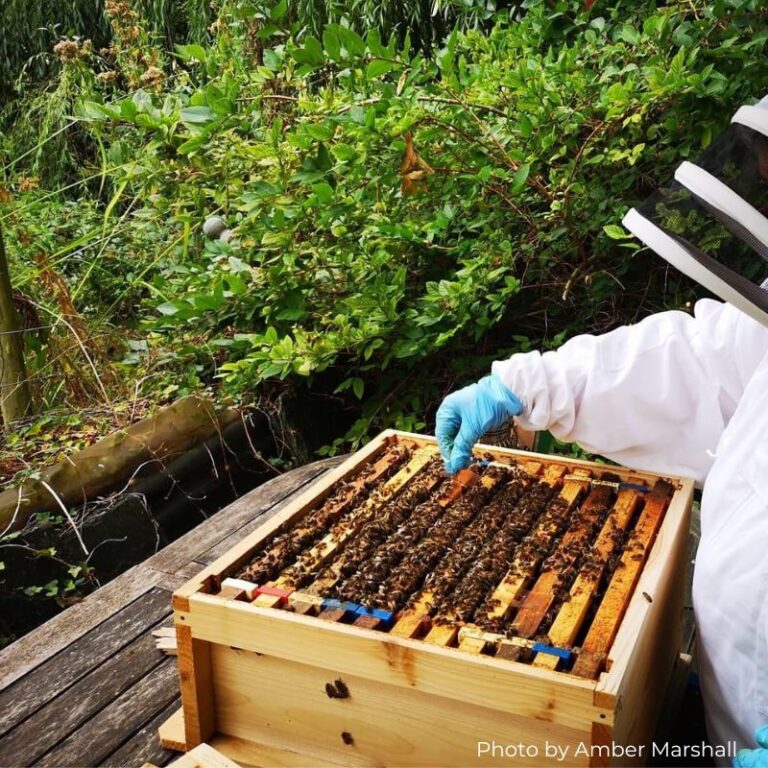
National Hives are square, and they hold eleven or twelve frames, similar to Langstroth style frames, but they are slightly smaller. National hive deep frames are 14 inches x 8.5 inches, while a Langstroth deep is 19 inches x 9 1/8 inches.
Frames can be hung in either of two directions, described as the “warm way” or “cold way,” since the hive is square. Lugs, the little ears at the top of the frame, are longer on the National frames (1.5 inches on each side) than they are on Langstroth frames (7/8 inches on each side)
National hives can be adapted for beekeepers with different abilities in the same ways that people have adapted Langstroth hives.

National Hives are square, and they hold eleven or twelve frames, similar to Langstroth style frames, but they are slightly smaller. National hive deep frames are 14 inches x 8.5 inches, while a Langstroth deep is 19 inches x 9 1/8 inches.
Frames can be hung in either of two directions, described as the “warm way” or “cold way,” since the hive is square. Lugs, the little ears at the top of the frame, are longer on the National frames (1.5 inches on each side) than they are on Langstroth frames (7/8 inches on each side)
National hives can be adapted for beekeepers with different abilities in the same ways that people have adapted Langstroth hives.
Europe has a long beekeeping history, and because of this and the fact that many of the countries operate independent of each other, there are many types of hives that are popular in Europe. Unlike the United States, they don't share a common hive configuration and have a lot of compatibility issues because of this.
Foxhound Bee Company
Europe has a long beekeeping history, and because of this and the fact that many of the countries operate independent of each other, there are many types of hives that are popular in Europe. Unlike the United States, they don't share a common hive configuration and have a lot of compatibility issues because of this.
Foxhound Bee Company
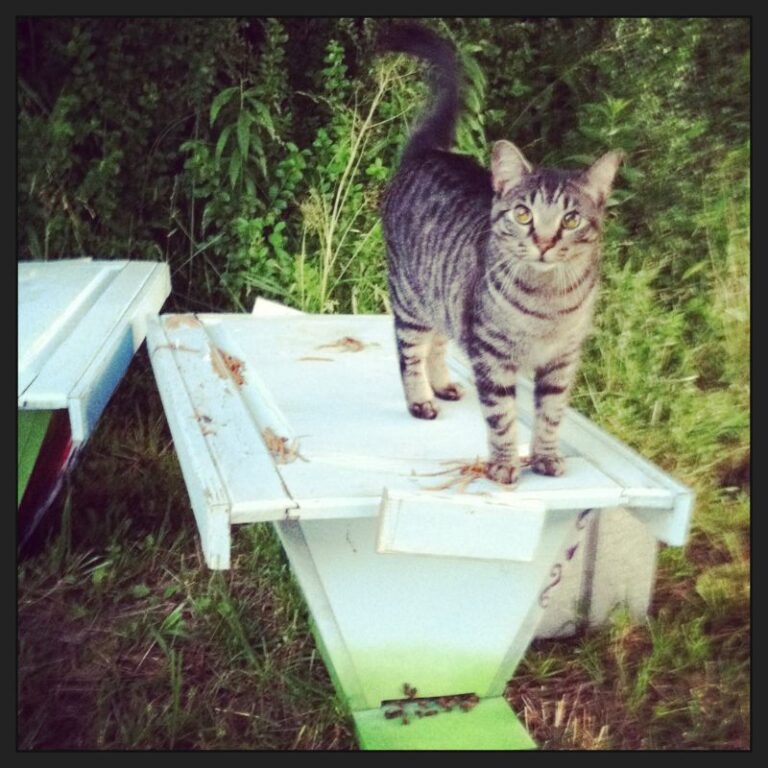
Top Bar Hives
Top bar hives are a type of horizontal hive. In a top bar hive, there are no frames, only wooden bars that rest at the top of the hive box. Honeybees build naturally shaped comb that hangs from the top bars, and the beekeeper must manage the frames to prevent cross-comb building, a situation in which the bees build the comb across multiple bars.
Cross-comb building can make it nearly impossible to lift the comb out of the hive, and a neglected top bar hive can get out of hand really quickly! We kept a top bar hive for many years and really did like using it.

Top Bar Hives
Top bar hives are a type of horizontal hive. In a top bar hive, there are no frames, only wooden bars that rest at the top of the hive box. Honeybees build naturally shaped comb that hangs from the top bars, and the beekeeper must manage the frames to prevent cross-comb building, a situation in which the bees build the comb across multiple bars.
Cross-comb building can make it nearly impossible to lift the comb out of the hive, and a neglected top bar hive can get out of hand really quickly! We kept a top bar hive for many years and really did like using it.
Beekeepers might choose to keep top bar hives because this set-up allows honey bees to draw out comb and cells to whatever size they want to build them. Because of this, top bar hives appeal to people who are interested in a way to do more “natural” beekeeping. (It is also possible to get this natural comb in other hive styles by using foundationless frames.) With a top bar hive, there is no need to add honey supers to the top like in vertical hives.
All types of horizontal hives can be made accessible for people with disabilities. Beekeepers will be able to do basic hive maintenance that they might not otherwise be able to do because they don’t have to lift or pry apart heavy boxes.
Beekeepers might choose to keep top bar hives because this set-up allows honey bees to draw out comb and cells to whatever size they want to build them. Because of this, top bar hives appeal to people who are interested in a way to do more “natural” beekeeping. (It is also possible to get this natural comb in other hive styles by using foundationless frames.) With a top bar hive, there is no need to add honey supers to the top like in vertical hives.
All types of horizontal hives can be made accessible for people with disabilities. Beekeepers will be able to do basic hive maintenance that they might not otherwise be able to do because they don’t have to lift or pry apart heavy boxes.
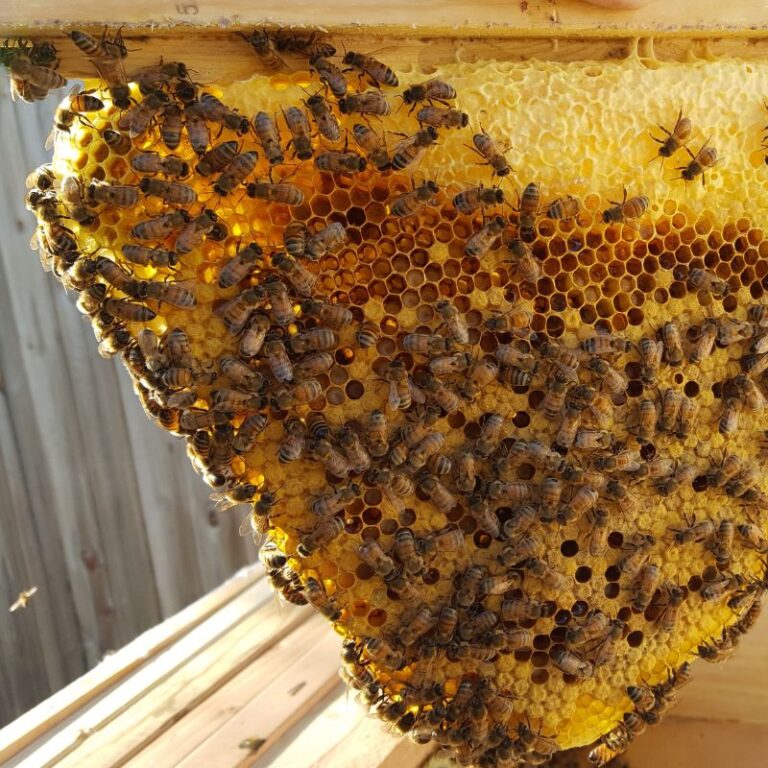
When it is time to harvest honey, a top bar beekeeper has to extract honey using the crush and strain method, sacrificing comb to get honey. Top bar frames won’t fit in a regular honey extractor. Inspections can be difficult because of cross-comb building, and the weight of the comb can cause it to fall off the top bar if it is lifted improperly.
We actually used a top bar hive for several years, and it really toughs us a lot about how bees use their space. They aren’t for everyone, but we really like using a top bar hive for a few years. We stopped using it because little difficult to use different types of beehives.

When it is time to harvest honey, a top bar beekeeper has to extract honey using the crush and strain method, sacrificing comb to get honey. Top bar frames won’t fit in a regular honey extractor. Inspections can be difficult because of cross-comb building, and the weight of the comb can cause it to fall off the top bar if it is lifted improperly.
We actually used a top bar hive for several years, and it really toughs us a lot about how bees use their space. They aren’t for everyone, but we really like using a top bar hive for a few years. We stopped using it because little difficult to use different types of beehives.
Warré Hives (Also Known As “People’s Hives”)
Warré Hives (Also Known As “People’s Hives”)
The Warré hive is square, smaller than Langstroth-style boxes, and is meant to feel like a hollow tree for the honey bees. Most often, this type of hive uses top bars only, letting the bees build natural comb. The Warre hive differs from most other hives in that the beekeeper adds boxes to the bottom instead of the top of the hive (a process called “nadiring”); therefore, as boxes full of honey are removed from the top, new boxes are added to the bottom, where the honey bees build brood comb anew.
If a hive is very strong, and there is a nectar flow, it may be possible to add a box to the top to get fresh comb for honey, but usually when a box cycles up to the top, it will be filled with honey in comb that was previously used for brood.
Warre hives include “quilt boxes,” which can be filled with wood shavings to absorb moisture from the hive and provide insulation. The quilt box has a cloth between it and the top box to keep worker bees from propolizing the boxes together.
Enthusiasts say that Warre style hives are low maintenance and simple to use. They say that the comb is continually being refreshed as beekeepers remove top boxes to extract honey using the crush and strain method. None of the comb ever gets very old, so minimal buildup of pesticides is possible.
Because of the heavy lifting required to add boxes, the Warre hive style may not be the best option for beekeepers in wheelchairs or with back injuries.
The Warré hive is square, smaller than Langstroth-style boxes, and is meant to feel like a hollow tree for the honey bees. Most often, this type of hive uses top bars only, letting the bees build natural comb. The Warre hive differs from most other hives in that the beekeeper adds boxes to the bottom instead of the top of the hive (a process called “nadiring”); therefore, as boxes full of honey are removed from the top, new boxes are added to the bottom, where the honey bees build brood comb anew.
If a hive is very strong, and there is a nectar flow, it may be possible to add a box to the top to get fresh comb for honey, but usually when a box cycles up to the top, it will be filled with honey in comb that was previously used for brood.
Warre hives include “quilt boxes,” which can be filled with wood shavings to absorb moisture from the hive and provide insulation. The quilt box has a cloth between it and the top box to keep worker bees from propolizing the boxes together.
Enthusiasts say that Warre style hives are low maintenance and simple to use. They say that the comb is continually being refreshed as beekeepers remove top boxes to extract honey using the crush and strain method. None of the comb ever gets very old, so minimal buildup of pesticides is possible.
Because of the heavy lifting required to add boxes, the Warre hive style may not be the best option for beekeepers in wheelchairs or with back injuries.
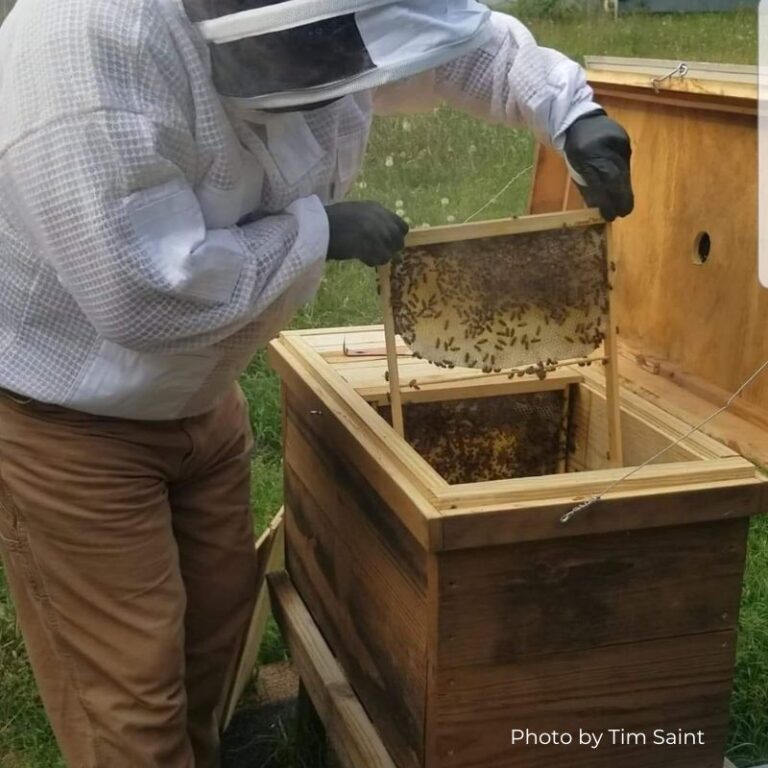
Layens Hives
Popular in Europe, the Layens hive is the original horizontal hive. It incorporates big hives and big frames to minimize swarming, produce lots of honey, and build up a strong population that can survive winter on its very deep frames.
Layens frames are 13×16, twice as deep as a Langstroth deep but not as wide. The boxes utilize a division board or follower board to limit space until the bees fill out the frames. People who use Layens hives like the ease of the horizontal hive setup. No heavy lifting is necessary.
A full frame of honey in a Layens hive is 8-12 pounds. There are companies that manufacture and sell extractors to fit Layens frames.

Layens Hives
Popular in Europe, the Layens hive is the original horizontal hive. It incorporates big hives and big frames to minimize swarming, produce lots of honey, and build up a strong population that can survive winter on its very deep frames.
Layens frames are 13×16, twice as deep as a Langstroth deep but not as wide. The boxes utilize a division board or follower board to limit space until the bees fill out the frames. People who use Layens hives like the ease of the horizontal hive setup. No heavy lifting is necessary.
A full frame of honey in a Layens hive is 8-12 pounds. There are companies that manufacture and sell extractors to fit Layens frames.
AZ Hives Or Slovenian AZ Hive
AZ Hives Or Slovenian AZ Hive
AZ hives are a great option if you don’t want to do any regular heavy lifting. Originating in Slovenia, these hives use frames, but the beekeeper removes them like books off a shelf, sliding them out from the back of the hive.
AZ hives are designed to be stacked with other hives and placed under a larger structure with a roof, with the bee entrances on the outside. This helps to keep the bees warm during the cold season. . Stacking these hives under a roof with space behind the hives makes it possible for the beekeeper to inspect hives even if it there is inclement weather.
AZ hives can use Langstroth frames, but upside down—with the top bar down. Most AZ hives come with observation windows so the beekeeper can peek in at the bees working, and a door that opens from the back for removing and inspecting frames.
AZ hives are a great option for people who have physical limitations. There is no heavy lifting required to reach frames, and the frames of honey can be extracted in extractors designed for Langstroth hives.
This YouTube video will show you what AZ hives look like and how they work.
AZ hives are a great option if you don’t want to do any regular heavy lifting. Originating in Slovenia, these hives use frames, but the beekeeper removes them like books off a shelf, sliding them out from the back of the hive.
AZ hives are designed to be stacked with other hives and placed under a larger structure with a roof, with the bee entrances on the outside. This helps to keep the bees warm during the cold season. . Stacking these hives under a roof with space behind the hives makes it possible for the beekeeper to inspect hives even if it there is inclement weather.
AZ hives can use Langstroth frames, but upside down—with the top bar down. Most AZ hives come with observation windows so the beekeeper can peek in at the bees working, and a door that opens from the back for removing and inspecting frames.
AZ hives are a great option for people who have physical limitations. There is no heavy lifting required to reach frames, and the frames of honey can be extracted in extractors designed for Langstroth hives.
This YouTube video will show you what AZ hives look like and how they work.
Flow Hives
Flow Hives
In 2015, inventor Cedar Anderson and his father posted their idea for a hive that made harvesting honey easier on a crowd fundraising platform, and the response was incredible. They designed a Flow hive that extracted its own honey. Who wouldn’t be interested in that?
The Flow hive is basically just a different style of Langstroth hive. It won’t make beekeeping any easier, but it can make harvesting honey easier.
Beekeepers can buy whole hives made by Flow Hives, or they can buy specialized honey supers that fit on their Langstroth or National hives, and they can possibly be adapted to some other hives.
We have another whole blog you can check out about Flow Hives: Flow Hive: A Beekeeper’s Take on All the Buzz.
In 2015, inventor Cedar Anderson and his father posted their idea for a hive that made harvesting honey easier on a crowd fundraising platform, and the response was incredible. They designed a Flow hive that extracted its own honey. Who wouldn’t be interested in that?
The Flow hive is basically just a different style of Langstroth hive. It won’t make beekeeping any easier, but it can make harvesting honey easier.
Beekeepers can buy whole hives made by Flow Hives, or they can buy specialized honey supers that fit on their Langstroth or National hives, and they can possibly be adapted to some other hives.
We have another whole blog you can check out about Flow Hives: Flow Hive: A Beekeeper’s Take on All the Buzz.
Choosing The Right Hive For Your Beekeeping Adventure
Choosing The Right Hive For Your Beekeeping Adventure
You can get any kind of hive you want these days. If you are handy enough, you can invent and build your own beehive. When you are choosing, these are questions to consider:
- Where will you get additional equipment when you need it in a pinch? Is it available near you? A swarm of bees is not going to wait for your shipment to come in. If you buy something that is not standard, you’ll need to think ahead and order extra equipment to start with.
- Will you be able to inspect the hive you have chosen without help? If it is going to be too heavy to lift, will you have help, can you adapt the hive design, or do you need to reconsider your decision? There are options to match your ability.
- How do you want to harvest honey? Do you want to use an extractor and be able to re-use honeycomb, or will you be happy using crush and strain method, requiring the bees to build more comb every year? (You’ll get a lot of beeswax that way)
Whatever type of bee hive you choose, remember that the hive box or boxes are for your convenience, not the bees’. The bees will be happy in a hollow log or an outhouse toilet. Choose the hive body that works best for you and your abilities.
Other types of hives that are available that we will cover later are:
You can get any kind of hive you want these days. If you are handy enough, you can invent and build your own beehive. When you are choosing, these are questions to consider:
- Where will you get additional equipment when you need it in a pinch? Is it available near you? A swarm of bees is not going to wait for your shipment to come in. If you buy something that is not standard, you’ll need to think ahead and order extra equipment to start with.
- Will you be able to inspect the hive you have chosen without help? If it is going to be too heavy to lift, will you have help, can you adapt the hive design, or do you need to reconsider your decision? There are options to match your ability.
- How do you want to harvest honey? Do you want to use an extractor and be able to re-use honeycomb, or will you be happy using crush and strain method, requiring the bees to build more comb every year? (You’ll get a lot of beeswax that way)
Whatever type of bee hive you choose, remember that the hive box or boxes are for your convenience, not the bees’. The bees will be happy in a hollow log or an outhouse toilet. Choose the hive body that works best for you and your abilities.
Other types of hives that are available that we will cover later are:
